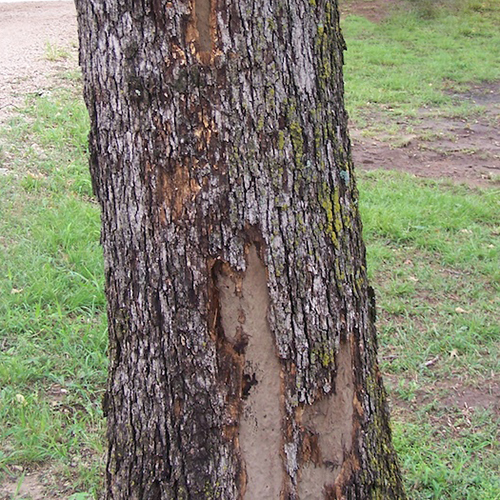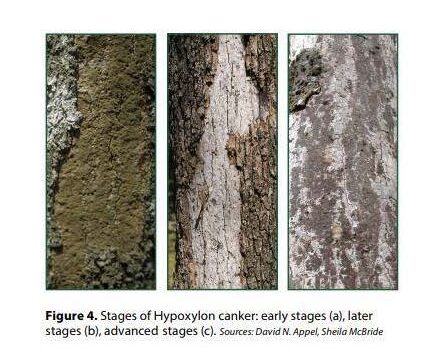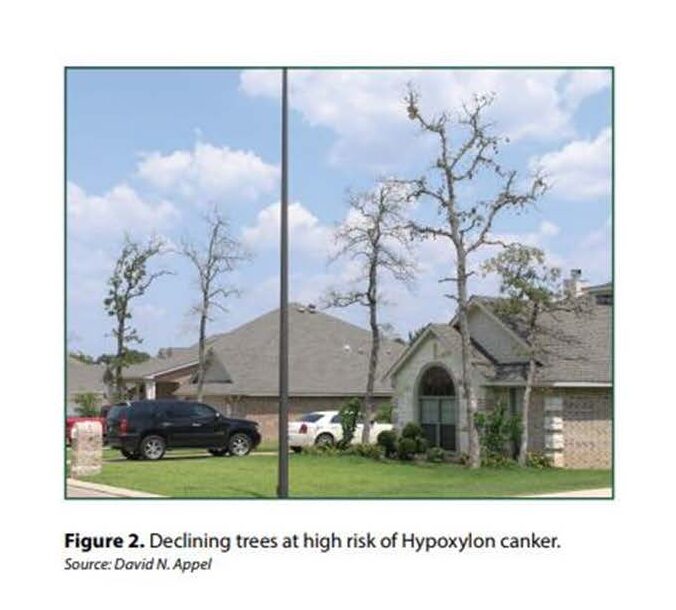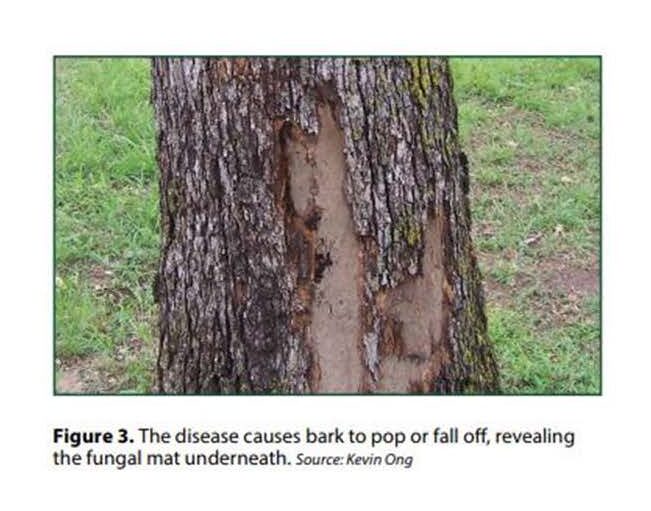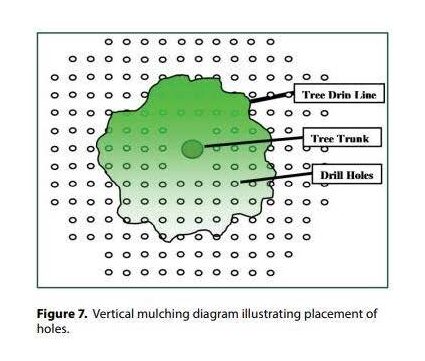Hypoxylon canker is a disease that appears as a dead lesion on limbs, branches, and trunks of affected trees. The canker develops just under the bark and in advanced stages, causes a white rot decay of the sapwood. This decay contributes to tree mortality, compromises the structural integrity of the tree, and makes it a danger to life and property.
Cause
Caused by the fungus Hypoxylon atropunctatum, hypoxylon cankers attacks hardwood trees such as oaks and pecans. It causes infected bark to slough off the pecan tree revealing a powder-like reddish substance on the wood. Infected wood will develop a brownish black crusty growth while infected trunks and limbs die. Water-stressed trees are susceptible to this fungal disease and — once infected — there is no control available. Maintaining proper care of the pecan tree, preventing soil compaction and protecting wounds by painting over them will help prevent hypoxylon canker.
The Biscogniauxia (Hypoxylon) atropunctatum fungus is an opportunistic pathogen, meaning it does not affect healthy and vigorous trees. However, Hypoxylon can quickly colonize weakened or stressed trees, occurring on trees growing in many habitats, such as forest sites, pastures, parks, green spaces, and urban development areas. Hypoxylon canker can affect any type of oak, including black, blackjack, laurel, live, post, southern red, Texas red, water, and white oaks.
Environmental Factors. Hypoxylon is a fungus and its spores spread from diseased to healthy trees. Opportunistic fungi, usually already present on many trees, cause disease when the tree’s resistance is insufficient to prevent the fungi from infecting it. Many sources of stress can decrease resistance to opportunistic pathogens.
Urban Development. Many factors in urban environments stress trees and can set in motion a chain of events that leads to stress, decline, and tree death.
- Construction damage wounds roots and causes site disruption that results in tree stress and decline.
- Construction of driveways, patios, sidewalks, and swimming pools can damage essential roots and root flares that provide necessary water and minerals for a healthy tree.
- Soil compaction and adding fill soil causes drainage issues and suffocates roots
Natural Factors. Climatic conditions such as drought, flooding, hail damage, heat, ice storms, and lightning can predispose trees to Hypoxylon infection. Insect attacks and other diseases such as oak wilt and root rots also induce stress and make a tree susceptible.
The signs of the fungus are:
- Early stages – Light to dark reddish-brown to olive-green crusty fungal (stroma) tissue over the cankered area (Fig. 4a)
- Later stages – Grey surface that eventually flakes off after 6 to 12 months to reveal a dark brown to black crusty material that gives the tree a burnt appearance (Fig. 4b)
- Advanced stages – Small patches a few inches long that will eventually merge into large strips along the trunk and major limbs of the tree (Fig. 4c)
Once Hypoxylon canker is evident, it is usually too late to try to save the tree. Large portions of the tree will be dead, reducing its desirability as a landscape specimen. The structural integrity of the wood is also compromised, and the tree becomes a hazard. Carefully inspect and consider removing trees with symptoms of Hypoxylon canker.
Symptoms
Trees stressed by environmental extremes and in danger of succumbing to Hypoxylon canker manifest symptoms typical of a declining tree (Fig. 2). These symptoms include:
- Yellow, brown leaves
- Small leaves and reduced twig growth
- thinning canopy
- Dead limbs and branches
- Epicormic shoots (water sprouts) growing on trunks and large limbs
- Dieback of feeder roots
- White and stringy sapwood in the cankered area
As these symptoms progress, the outer bark falls from the tree to expose the fungus, Biscogniauxia (Hypoxylon) atropunctatum, that causes the disease (Fig. 3).
Control
Managing the disease depends on maintaining vigorous, healthy trees, preventing the factors that lead to stress, and allowing the tree’s natural resistance mechanisms to inhibit the pathogen. If a tree succumbs to stress, take measures to reverse the condition before the pathogen can invade. Remedial action should maximize the regeneration of the root system and allow the tree to cope with the subsequent strain.
Vertical Mulching. An aggressive way to improve the soil environment and stimulate feeder roots is through vertical mulching. In addition to fertilizing and root zone aeration, vertical mulching increases gaseous exchange in the root system. It also lessens damage from excessive water, provides necessary aeration during wet periods, allows water penetration during drought, and promotes the formation of fine feeder roots. With vertical mulching, a porous matter such as pea gravel, sand, or a mixture of compost with pea gravel, rice hulls, or sand is added to holes drilled throughout the root zone of the tree (Fig. 7). The holes should be 18 to 24 inches deep and a few inches in diameter.
Remedial Pruning. If 15 percent or less of the canopy is affected, use proper pruning practices to remove all dead branches. If specific branches are infected, carefully remove those branches, making sure to remove all of the infected tissue. Sanitation pruning consists of cutting an infected branch 8 to 12 inches below the visible injury or canker. To avoid spreading pathogen during pruning, sanitize the pruning tool before each cut with a 10 percent solution of bleach (one part bleach to nine parts water). To prevent rust, dry and oil tools after use.
Tree removal. If more than 15 percent of the canopy is infected, consider cutting the tree down. B. atropunctatum causes a white rot of the wood and trees killed by it may quickly become a hazard. Since the fungus is already present throughout a stand, destroying the wood to prevent further infections is questionable. Avoid storing diseased wood in the immediate vicinity of remaining trees.
